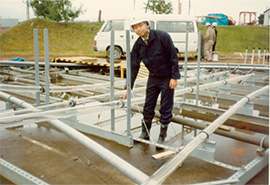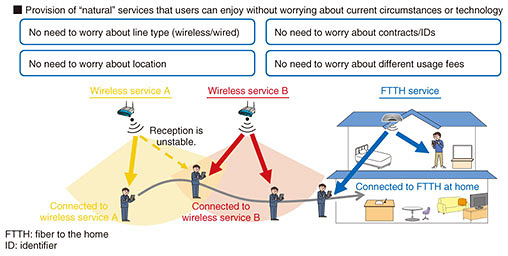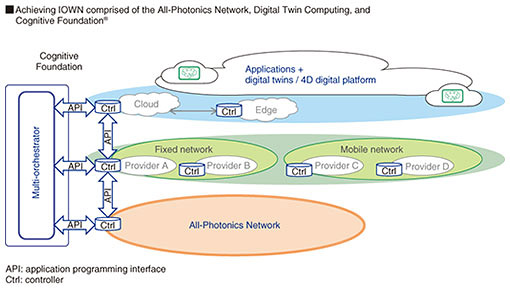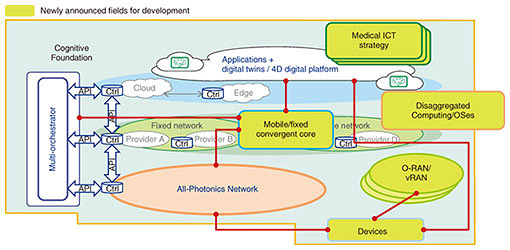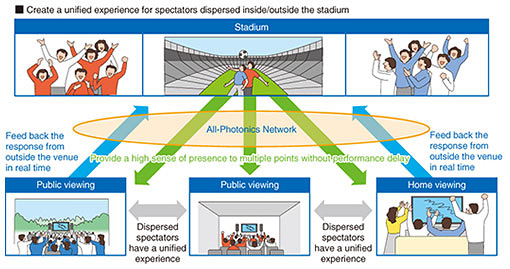 |
|||
|
|
|||
|
Feature Articles: Keynote Speeches/Workshop Lectures at Tsukuba Forum 2020 ONLINE Vol. 19, No. 4, pp. 14–21, Apr. 2021. https://doi.org/10.53829/ntr202104fa1  NTT Group°«s Initiatives for a Post-COVID-19 SocietyAbstractThis article introduces NTT Group’s initiatives for a Post-COVID-19 society. The content of this article is based on a keynote speech presented by Jun Sawada, president and chief executive officer of NTT, at the Tsukuba Forum 2020 ONLINE held October 29–30, 2020. Keywords: IOWN, All-Photonics Network, remote world 1. My involvement with Tsukuba R&D CenterTo begin with, I would like to talk about the special place I have in my heart for Tsukuba R&D Center. I first entered the company in 1978 (then, the Nippon Telegraph and Telephone Public Corporation) as an engineer assigned to the telephone line division (now the access division). In my first assignment, I made many visits to what is now the Joso City area near the Tsukuba R&D Center. Then, in my third year, I was assigned to what was then the technology section and put in charge of structures. It was at this time that I undertook the research and development of construction technology at the Technology Construction Center (now, NTT Access Network Service Systems Laboratories). At this research laboratory, the soil experimental building had facilities for driving a trailer with a 20-ton load at speeds of up to 60 km/h that could be used to conduct experiments on road loads and measuring their effects on manholes, conduits, and cables. Actually, this research had already been completed, but the last person to drive that trailer was me. As the person in charge of structures, I also experienced first-hand the hard work performed by those involved in disaster recovery. This photo that I carry around with me relates to experiments conducted at that time on freeze-proof polyethylene (PE) pipes with which problems had been occurring during cable laying (Photo 1). It shows how we would pull transparent PE pipes on land to emulate pulling within a conduit. These experiments examined the correlation between strain and the behavior of cables and PE pipe, tensile strength, number of cables, etc. I came to understand that conducting a series of such practical experiments enables us to operate our telecommunication facilities in a stable manner within a severe natural environment from several tens of degrees below to several tens of degrees above freezing. In the second half of this article, I will talk about the Innovative Optical and Wireless Network (IOWN), but let me say that even amazing technologies will not be accepted by society without such steady and dedicated research.
2. Global spread of COVID-19The novel coronavirus (COVID-19) continues to spread. While people are still practicing social distancing and signs of a slight economic recovery are appearing, the number of infected individuals is growing again. In Japan, COVID-19 is classified as a designated infectious disease, so an individual that tests positive is basically quarantined in a hospital, which increases the load on the medical care system. While the results of analysis have shown that an infected individual is most likely to spread the virus during the first week or so after the onset of symptoms, even an asymptomatic person can infect others. The number of new infections in Japan is lower than that in the United States and major European countries by about two orders of magnitude. While this reason is not yet fully understood, further research into explaining this state of affairs may uncover elements other than a vaccine or method of treatment that can change the effects of such an infectious disease. The NTT Group is not involved in this research, but I feel that steady research efforts must be made in making changes in society. The total number of infected individuals in the NTT Group is about 2400 as of October 29, 2020, which breaks down to about 400 in Japan and 2000 abroad. Unfortunately, 13 individuals have passed away, 2 in Japan and 11 abroad. I feel that we must be concerned about COVID-19 while dealing with it in an appropriate manner. Amid this increasing number of infected individuals due to COVID-19, what sort of impact is this pandemic having on the global economy? The gross domestic product (GDP) forecasts by country announced by the International Monetary Fund (IMF) show a somewhat slow recovery in the UK and Japan and signs of a recovery in the Eurozone and the United States with only China showing positive growth. The world on the whole shows signs of a recovery from negative growth (Fig. 1). At the same time, the purchasing managers’ index (PMI) shows that economic conditions in Japan fell during the country’s state of emergency (in early 2020) with a similar drop in other countries, and that developed countries other than Japan have moved into the positive side as of September 2020. These indices indicate that only Japan has yet to make an economic recovery, which may reflect the cautious traits of Japanese people (Fig. 2).
3. Creating a remote worldNext, I would like to take a look at trends for a post-COVID-19 society. One trend involves revitalizing the economy while achieving social distancing. I believe that achieving both simultaneously in a paraconsistent manner will lead to the creation of a remote world (dispersed society). In such an environment, could not the NTT Group offer some help from the perspective of information and communications technology (ICT)? This is one issue that we are now taking up. 4. Rise of new glocalismUp to now, we have come to consider the global free movement of people, goods, and money as natural. However, the situation is now changing. People can no longer move about freely, and we cannot move goods freely. This signals a strong emergence of localism (Fig. 3). Culture has been locally rooted, so it’s a concept contradictory to globalism. From here on, though, I think that both localism and globalism will be simultaneously achieved to create a world of “new glocalism.” Even in Japan, the expression “economic security” is beginning to be used, and such a trend will have a significant impact on the world of ICT.
5. Changes in the environment surrounding the telecommunications marketI have mentioned that creating a remote world and rise of new glocalism are two key trends for a post-COVID-19 society, but I would also like to point out two important changes that are now taking place in the telecommunications market against the background of those trends. One is the launching of fifth-generation mobile communications system (5G) services and technological development toward the sixth-generation mobile communications system (6G). With 6G, I believe that the barrier between fixed and mobile communications will become smaller or disappear altogether, so it will be necessary to provide integrated and seamless services. The other change is the coming of severe market competition beyond the telecommunications layer, that is, a change in competing players. For example, over-the-top providers will cover vertically integrated services from the application layer to the infrastructure layer, and terminal manufacturers will provide communication services using an embedded subscriber identity module (eSIM)* as a trigger. With this change in structure, borderless market competition will become all the more severe.
6. Road to IOWN (future directions)In 2019, we announced the concept of IOWN as a new information and communication infrastructure. The road to IOWN will be driven along four key directions: development/provision of new services that consider the remote world, concentration of resources and promotion of digital transformation (DX), implementation of research and development on a global scale, and enhancement of new businesses. In this article, I would like to discuss these future directions. 6.1 Development and provision of O-RAN + vRANIn the development/provision of new services that consider the remote world, we announced a business and investment tie-up with NEC Corporation in June 2020 for joint research and development. I will introduce the directions that we envision this tie-up will take. The first direction is the acceleration of the Open Radio Access Network (O-RAN). This is a model advocated by NTT DOCOMO to accelerate multi-vendor interoperability in partnership with NEC. It promotes a transition from the existing vertical integration model that is highly dependent on specific vendors to an O-RAN/vRAN (virtualized RAN) model to support white-box equipment and generic software in a multi-vendor environment. Therefore, both NTT and NEC plan to drive the spread of open architecture (Fig. 4). The next direction is collaboration on manufacturing devices and equipment. Our goal is joint development of a digital signal processor having both the world’s highest level of performance and low power consumption as well as information-communication equipment that will embed the processor. In the long run, we would like to connect these initiatives to our efforts in making IOWN a reality.
6.2 Development of mobile/fixed seamless servicesBeyond our promotion and development of the O-RAN/vRAN model, we would like to achieve cognitive communication that manages user presence (Fig. 5). From the user’s point of view, this means the ability to connect in a seamless manner using the most optimal communication environment regardless of location without having to worry about line type (wireless/wired), separate contracts, usage location, or different fees. In short, our goal is to achieve “natural” services.
6.3 Objective of converting NTT DOCOMO into a wholly owned subsidiaryNext, as part of the second key direction of concentration of resources and promotion of DX, we announced the conversion of NTT DOCOMO into a wholly owned subsidiary of NTT. The objective of this move is to enhance the competitiveness and growth of NTT DOCOMO and promote the growth of the entire NTT Group. By leveraging the power of NTT Communications and NTT Comware, we aim to promote new services and solutions and a 6G-oriented communications infrastructure in the form of mobile/fixed seamless services as I just described and to drive the further evolution of NTT DOCOMO into a comprehensive ICT enterprise that extends as far as upper-layer businesses. 6.4 IOWNIOWN can be expressed as a three-layer model (Fig. 6). In the middle of this model lies the network layer, which is currently divided into the fixed and mobile networks. In the future, though, the configuring of services will be centered about this layer. Supposing that 6G will be able to handle a communication capacity of more than ten times that of current 5G, the performance and capacity of optical fiber, fixed network, etc. that lie behind the scenes will naturally have to be raised. On a chip level, however, problems related to heat and efficiency present a strong barrier to these enhancements. The coming of the All-Photonics Network featuring photonics-electronics convergence as a key technology will help solve these problems. However, it will be Digital Twin Computing on an upper layer where many services using big data will be born. The All-Photonics Network and Digital Twin Computing will take on a cooperative existence. In addition, considering that efficiency is poor in the case of distributed networks, they will have to be connected. This is why an element called Cognitive Foundation® will be needed. These three elements—All-Photonics Network, Digital Twin Computing, and Cognitive Foundation—will become the basic framework of IOWN.
I believe that the convergence of core networks will be a prime driver in this development effort. The idea is that core-network components must work together to achieve a seamless connection between the mobile and fixed networks. At present, however, there are many nodes, systems, and networks that are being discussed in terms of voice communications and data communications, whether they should be consumer-oriented or business-oriented, etc., and research is needed to determine to what extent and in what form these elements should be converged. For this reason, close collaboration between NTT laboratories and the research laboratories of NTT DOCOMO is indispensable. Furthermore, if large volumes of data come to be processed using an open model, it will be necessary to study whether software and computer systems can operate under a disaggregated model. This, in short, means a migration to a serverless format by incorporating photonics-electronics convergence technology on the computer side as well. I also see the need for white boxes to support ultra-large-capacity, high-speed processing on such a platform. In the United States, we have established a company called NTT Research, Inc. composed of three research laboratories. The research conducted there includes topics in medical and health science, and going forward, I think there will be increasing interest in discussing how medical ICT can support everyone’s healthcare in the form of digital twins. Such a development will involve questions on how to deal with various types of wearable and implantable devices, so I think that the aforementioned fields of medical ICT strategy, mobile/fixed convergent core, disaggregated computing/operating systems (OSes), O-RAN/vRAN, and devices will attract attention as next-generation research and development themes from within IOWN (Fig. 7).
6.5 All-Photonics-Network use casesAs an official partner of Major League Baseball (MLB), NTT has been working to provide Ultra Reality Viewing experiences using its Kirari! technology, but in 2020, the effects of the COVID-19 pandemic put this initiative on hold. Spectator-based events have recently been changing into digital events, so we expect to be able to hold such events based on a dispersed remote world. Specifically, we would like to create a unified experience for spectators dispersed inside/outside the stadium. This will require the transmission of stadium information without delay to home-viewing or public-viewing sites and the feeding back of the reactions of those spectators to the stadium, likewise without delay. This, in turn, will require the All-Photonics Network to have extremely low delay (Fig. 8). We can treat such an event as an All-Photonics-Network use case.
In addition, quantum cryptography and quantum communication are two fields that are increasingly being taken up, and the All-Photonics Network will expand the range in which quantum cryptography can be applied by approaching optical end-to-end communications. In fact, the development of the All-Photonics Network simultaneously takes into account support of quantum cryptography and quantum communication. 7. Access network on IOWNI would like to see NTT Access Network Service Systems Laboratories enhance the access network toward IOWN. They have been researching and developing various elements and systems, but from here on, I think it’s necessary that they go beyond today’s research and development stage and study means of dealing with demand that optical fiber in the field today would not be able to cover. For example, a decision must be made on whether to overlay or replace the present access network with a new system. Looking ahead ten years, I see an end to today’s basic design model of fiber to the home (FTTH) in which optical fiber is allocated in single-wavelength format or fixed wiring intervals from the perspective of planned economics. I can imagine a hybrid access system that, depending on the demand, provides access by a base station’s backhaul or fronthaul or by direct connection to a building, or that provides services in terms of wavelength or by conventional FTTH. A transition period and transition scheme must be studied to decide on how to absorb new infrastructure while having it coexist with existing equipment. The fixed access network, in particular, will continue to be provided to both individual and corporate customers. I think the era is coming in which mobile communications or the customer’s local 5G infrastructure system can be used for access. I would like to research and develop such technologies and promote research and development and business on a global scale so that we will be able to provide NTT Group systems throughout the world. 8. Concluding remarksAt the beginning of this article, I talked about the hardships we faced 40 years ago in development work. The research themes that I managed were often directly connected to work in the field, and I was often reprimanded for problems in the field when I went to regions throughout Japan. It would sometime happen that some procedure was done in a way different from the usual way causing, for example, stripped threading in equipment. Then, while thinking of how to develop a system or equipment technology that could reliably handle such irregular events, I would always be trying to overcome the thinking of “it must be done this way” or “this is the way it’s always been done.” I hope that we, the NTT Group, can work with our partners to overcome this thinking within us and create a world in which we can make new technologies. |
|||









